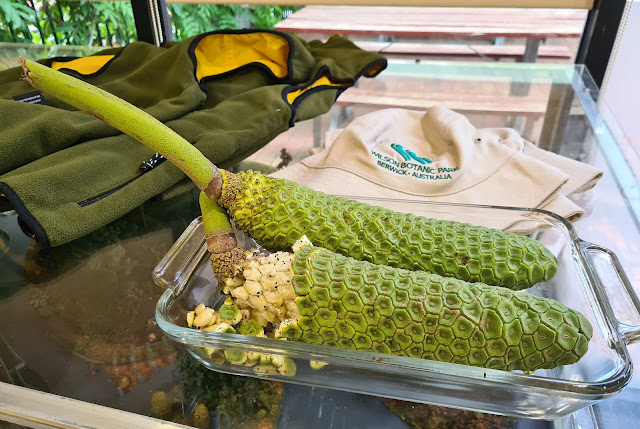Monstrous fruit worth the trouble for some
It's hardly the same as eating a Japanese fugu (Puffer Fish) - which might kill you if not cooked appropriately - but eating the fruit of a Monstera deliciosa (Fruit Salad Plant or Swiss Cheese Plant) does carry some risks.
This fruit, and the collection of flowers before it, are clustered around and slightly embedded into a fleshy stem. We call this a spadix, and the white bract that partly encloses it during flowering, a spathe. You find this kind of floral arrangement in all members of the Arum Lily family, Araceae, including the Swiss Cheese Plant.
On the positive side, the ripened fruit tastes like bananas or pineapple. Others say custard apple.
I hadn't tried it until Michael Chong, a member of the Friends of Wilson Botanic Park Berwick, dashed home before I was about to give a talk to the group as part of their Annual General Meeting and brought back two ripening fruits. How could I refuse?
In an earlier post about why the Swiss Cheese has holes in its leaves, I suggested you only eat the fruit with some careful planning. I can now confirm that with some guidance, you can enjoy what to some is a flavoursome tropical fruit.
The key is to wait until the green hexagonal (or sometimes pentagonal) scales loosen to reveal the pulp beneath, then dig in with a spoon. One fruit had already popped a few of the outer scales, revealing the off-white pulp beneath. The second fruit had one or two kernels loosening and would be good to eat in a day or so.
Was it any good? For me, too flavoursome (I don't like bananas and tolerate pineapples) and sweet (a bit sickly but then I'm more a savoury guy), but not unpleasant. And not at all irritating - unlike me when someone leaves a banana skin in a nearby bin, or car.
I took it home (thanks Michael) and we ate some more it progressively ripened. I gather you get more of it to ripen in one hit by placing the fruiting stalk in water and keeping it in the dark for a few days. I was happy to have small doses every few days.
If you are careful, this is something you can try at home. The plants are readily available to grow indoors but you'll need to take it outside to get fruit - just check it isn't a potential weed in your local area. The species grows naturally in tropical forests from southern Mexico to Panama, and in cultivation in Australia, it will fruit from the tropics right down to at least Melbourne.






Comments